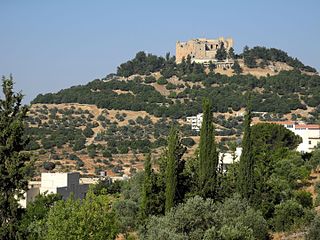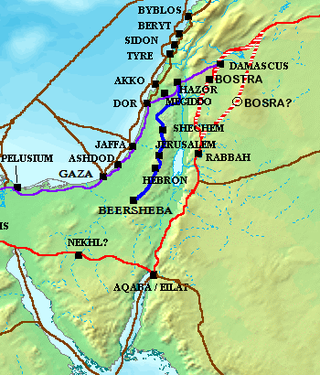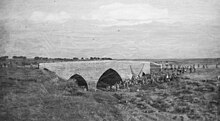
Ashdod is the sixth-largest city in Israel. Located in the country's Southern District, it lies on the Mediterranean coast 32 kilometres south of Tel Aviv and 20 km (12 mi) north of Ashkelon.

Yavne or Yavneh is a city in the Central District of Israel. In 2022, it had a population of 56,232.

Isdud was a Palestinian village tracing back at least to the Ottoman period of the Palestine region. In 1945, it had a population of 4,620 Arabs and 290 Jews, three years prior to the 1948 Arab-Israeli War, during which the Arab inhabitants either fled or were expelled.

The Sellwood Bridge is a deck arch bridge that spans the Willamette River in Portland, Oregon, in the United States. The current bridge opened in 2016 and replaced a 1925 span that had carried the same name. The original bridge was Portland's first fixed-span bridge and, being the only river crossing for miles in each direction, the busiest two-lane bridge in Oregon. The Sellwood Bridge links the Sellwood and Westmoreland neighborhoods of Portland on the east side with Oregon Route 43/Macadam Avenue on the west side. At its east end it leads to Tacoma Street. The bridge is owned and operated by Multnomah County. The original span of 1925 was a steel truss bridge, while its 2016 replacement is a deck-arch-type bridge.

Ad Halom is a site at the eastern entrance to the city of Ashdod, Israel, where three bridges cross the Lakhish River.

Minat al-Qal'a is a medieval coastal fort protecting the port known as Ashdod-Yam, which was historically separate from Ashdod proper but whose archaeological remains are today located on the southern beach of the sprawling modern city of Ashdod. The fort was built by the Umayyads and later restored by the Crusaders.
Darkush is a town in northern Syria, administratively part of the Idlib Governorate, located northwest of Idlib along the Syrian–Turkish borders on the Orontes River. Nearby localities include al-Janudiyah, Zarzur and al-Najiyah to the southwest, Jisr al-Shughur to the south and Millis and Maarrat Misrin to the east. According to the Syria Central Bureau of Statistics, Darkush had a population of 5,295 in the 2004 census. The town is also the administrative center of the Darkush nahiyah which consists of 19 villages with a combined population of 23,022. Its inhabitants are predominantly Sunni Muslims.

Gesher Bnot Ya'akov is a bridge that spans the last natural ford of the Jordan River at the southern end of the Hula Basin between the Korazim Plateau and the Golan Heights. It has been a crossing point for thousands of years.

The Great Mosque of Gaza, also known as the Great Omari Mosque, was the largest and oldest mosque in the Gaza Strip, Palestine, located in Gaza City.

Lajjun was a large Palestinian Arab village located 16 kilometers (9.9 mi) northwest of Jenin and 1 kilometer (0.62 mi) south of the remains of the biblical city of Megiddo. The Israeli kibbutz of Megiddo, Israel was built 600 metres north-east of the depopulated village on the hill called Dhahrat ed Dar from 1949.

Operation Pleshet was an Israeli military action near the village of Isdud from May 29 to June 3, 1948 during the 1948 Arab–Israeli War. Isdud was on the Israeli southern front against the Egyptian Army, and the operation was aimed at capturing the village and stopping the Egyptian advance northwards. While only the June 2–3 engagements are officially named Operation Pleshet, the events immediately preceding are historiographically joined with it.

Tel Aviv Promenade runs along the Mediterranean seashore in Tel Aviv, Israel.

Jisr Jindas, Arabic for "Jindas Bridge", also known as Baybars Bridge, was built in 1273 CE. It crosses a small wadi, known in Hebrew as the Ayalon River, on the old road leading south to Lod and Ramla. The bridge is named after the village of Jindas, which until 1948 stood east of the bridge and may have been the Crusader-period "casal of Gendas" mentioned in a Latin charter dated 1129 CE. It is the most famous of the several bridges erected by Sultan Baybars in Palestine, which include the Yibna and the Isdud bridges.

The Yibna Bridge or Nahr Rubin Bridge is a Mamluk arch bridge near Yibna, which crosses the river Nahal Sorek. It was previously used by Route 410 to Rehovot, and was known as the Jumping Bridge due to a bump in the middle of the bridge which caused cars to jump if speeding. It is now a part of a recreation ground, next to a new bridge carrying the Route 410.

Ajloun Castle, medieval name Qalʻat ar-Rabad, is a 12th-century Muslim castle situated in northwestern Jordan. It is placed on a hilltop belonging to the Mount Ajloun district, also known as Jabal 'Auf after a Bedouin tribe which had captured the area in the 12th century. From its high ground the castle was guarding three wadis which descend towards the Jordan Valley.It was built by the Ayyubids in the 12th century and enlarged by the Mamluks in the 13th.

The Road of the Patriarchs or Way of the Patriarchs is an ancient north–south route traversing the land of Israel and the region of Palestine. The modern Highway 60 (Israel-Palestine) follows roughly the route of the Way of the Patriarchs. The name is used by biblical scholars because of mentions in biblical narratives that it was frequently travelled by Abraham, Isaac and Jacob.

Jisr ed-Damiye, known in English as Damiyah Bridge, as Prince Muhammad Bridge in Jordan, and as Gesher Adam in Israel, stretches over the Jordan River between the Palestinian territories and the town of Damia in the Balqa Governorate of Jordan.

Jisr el-Majami or Jisr al-Mujamieh is an ancient stone bridge, possibly of Roman origin, over the Jordan River on the border between Israel and Jordan. The name is derived from the bridge's location 200 m (660 ft) south of the confluence of the Yarmouk and Jordan rivers.

Wellesley Bridge, Srirangapatna is an ancient stone bridge built in 1804 on the Highway road leading to Bangalore from Mysore in the state of Karnataka. This stone bridge is built across the north bank of the Cauvery River. When built it was the main first artery approach to the island town of Srirangapatna which was initially the capital city of the Wodeyar Dynasty of Mysore Kingdom after the death of Tipu Sultan in 1799. The bridge was dedicated to Marquis Wellesley who was the Governor-General of British India when it was completed, and it was inaugurated in October 1804. It was built under the overall supervision of Dewan, Purnaiah of the Kingdom of Mysore, as directed by the King Mummadi Krishnaraja Wodeyar.

Ashdod or Azotus was an ancient Levantine metropolis situated at Tel Ashdod, 'Mound of Ashdod', an archaeological site co-located with the remains of the former Ottoman-era and now depopulated Palestinian village of Isdud, a few kilometers south of the modern Ashdod in present-day Israel.























